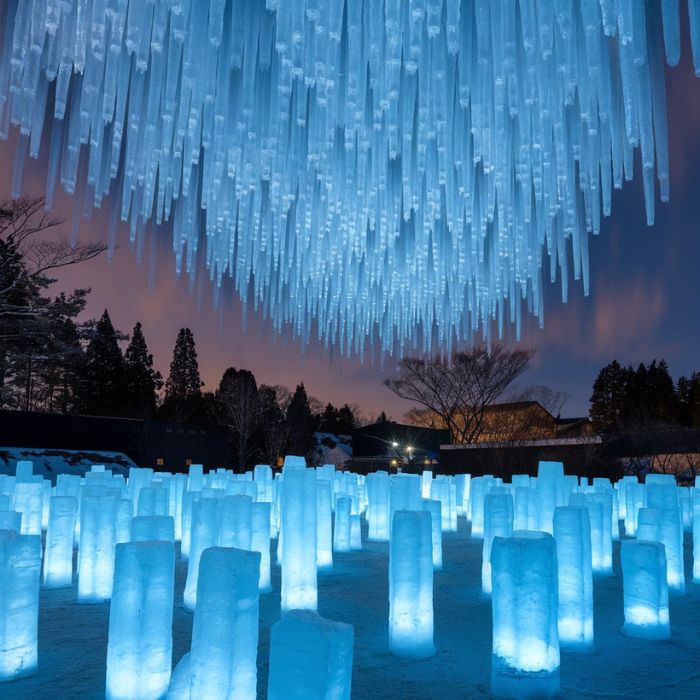Overview of Light Pillars
Nature has a way of surprising us. Just when we think we’ve seen it all, it unveils something magical. One such mesmerizing phenomenon is the Japanese light pillar. These stunning vertical beams of light seem to rise from the horizon, creating an enchanting spectacle that captivates those fortunate enough to witness them.
Imagine standing outside on a crisp winter night and suddenly being greeted by giant columns of shimmering light piercing through the air. It’s an experience that feels almost otherworldly. The beauty and rarity of these natural displays have made them a significant part of Japan’s rich tapestry of cultural wonders.
As we explore this fascinating subject further, you’ll discover not just what these pillars are but also the science behind their formation, their cultural significance in Japan, and where you can see this breathtaking sight for yourself. Prepare to be amazed by nature’s artistry as we dive into the world of Japanese light pillars!
What are Japanese Light Pillars?
Japanese light pillars are a captivating atmospheric phenomenon. They appear as vertical shafts of light, seemingly rising from the horizon into the sky.
These optical delights occur when ice crystals in the atmosphere refract sunlight or moonlight. The result is an ethereal display that can leave observers awestruck.
While they can be found globally, Japan has a special connection to these stunning visuals. In certain regions, they manifest with remarkable clarity and brilliance.
The sight evokes feelings of wonder and tranquility. Many see them as nature’s fleeting art, reminding us of the beauty hidden within our world’s climate dynamics.
The Science behind Light Pillars
Japanese light pillars are mesmerizing optical phenomena that occur under specific atmospheric conditions. They appear as vertical columns of light extending above or below a source, often resembling glowing beams piercing the sky.
The science behind them involves ice crystals suspended in the atmosphere. These tiny, hexagonal plates act like prisms and mirrors. When sunlight or moonlight strikes these crystals at certain angles, they reflect and refract the light.
This process can create stunning visual displays during cold weather when temperatures drop low enough for ice to form in the air. The result is an enchanting illusion—nature’s own spotlight illuminating the scene beneath it.
These ephemeral structures can vary in intensity and length depending on crystal orientation and size. Their transient nature adds to their allure; one moment they’re there, then just as quickly they fade away into darkness.
Origin and Formation of Japanese Light Pillars
Japanese light pillars originate from a unique set of atmospheric conditions. These captivating displays occur when sunlight reflects off ice crystals suspended in the air.
During cold winter nights, tiny hexagonal plates form in the atmosphere, especially in regions with frigid temperatures. As light passes through these crystal structures, it bends and creates vertical beams that appear to rise or descend from the horizon.
The clarity of the sky plays an essential role in this phenomenon. A clear night enhances visibility and amplifies the brilliance of these ethereal columns.
Local geography also contributes to their formation. Cities surrounded by mountains often experience colder microclimates where such ice crystals are more prevalent.
Witnessing light pillars can feel almost otherworldly, as they transform ordinary landscapes into mesmerizing spectacles filled with shimmering colors and enchanting hues.
Cultural Significance of Light Pillars in Japan
In Japan, light pillars hold a special place in cultural reverence and folklore. These stunning phenomena are often seen as celestial messengers, bridging the earthly realm with the divine.
Many locals associate light pillars with good fortune or spiritual insights. They believe that witnessing this natural wonder can bring clarity during times of uncertainty.
Traditional Japanese art sometimes features light pillars, symbolizing hope and enlightenment. This connection to nature reflects the broader ethos of harmony found in Japanese culture.
Festivals celebrating seasonal changes may also incorporate themes inspired by these luminous displays. Such events invite communities to gather under radiant skies, sharing stories and experiences related to their sightings.
Light pillars weave into the rich tapestry of Japan’s cultural narratives, reminding people of nature’s beauty and mystery while inspiring awe for its intricate designs.
Best Places to See Light Pillars in Japan
Japan offers some remarkable spots to witness the enchanting phenomenon of light pillars. One of the top locations is Hokkaido, especially during winter months. The cold air creates perfect conditions for these stunning displays.
Another great place is Lake Shikotsu, known for its serene views and tranquil atmosphere. When temperatures drop, visitors can sometimes catch a glimpse of this ethereal sight against the backdrop of frozen lakes.
Yokohama also deserves a mention. Urban settings can enhance the visual experience as city lights mingle with nature’s wonders.
For those in northern regions, cities like Sapporo and Asahikawa frequently showcase these magical pillars in their clear winter skies.
Each location provides not only breathtaking visuals but also diverse experiences that celebrate Japan’s natural beauty amidst urban landscapes or peaceful retreats.
How to Photograph Japanese Light Pillars
Capturing Japanese light pillars requires some thoughtful planning. Start by choosing a location known for this phenomenon, preferably during winter months when they is most visible.
Use a tripod to stabilize your camera. This ensures clear shots in low light conditions. A longer exposure often helps reveal the subtle details of these vertical beams.
Adjust your ISO settings carefully; too high can introduce noise, while too low may lead to dark images. Experiment with different shutter speeds until you find what best showcases the pillars’ brilliance.
Consider framing your shot thoughtfully. Surrounding elements, like trees or buildings, can add context and depth, enhancing the overall composition.
Don’t forget about post-processing! Enhancing contrast and brightness can bring out colors that might be missed on camera, making those stunning light pillars truly pop on screen.
Conclusion:
Appreciating the Beauty of Nature’s Mysteries
Nature is full of surprises, and Japanese light pillars are a stunning example. These natural wonders remind us of the delicate dance between science and beauty. As we stand in awe beneath their luminous glow, we connect with something larger than ourselves.
Experiencing these phenomena offers a unique opportunity to reflect on our place within the world’s intricate tapestry. Light pillars serve as a reminder that even in our fast-paced lives, there are moments of quiet wonder waiting to be discovered.
Whether you’re an avid photographer or simply a lover of nature’s mysteries, seeking out light pillars can lead to unforgettable experiences. The joy found in witnessing such extraordinary sights fosters appreciation for the planet we call home.
So next time you find yourself under a clear winter sky in Japan, take a moment to look up. You never know what breathtaking spectacle might illuminate your path.











